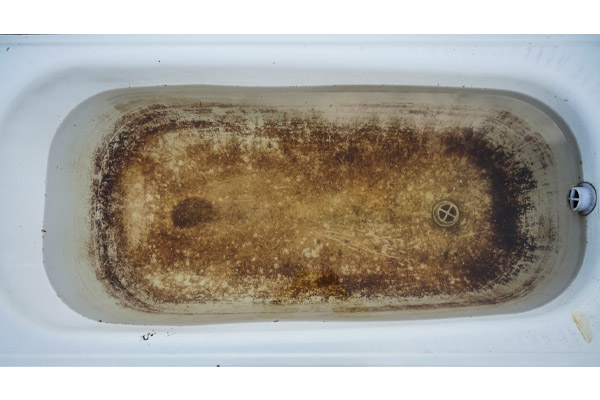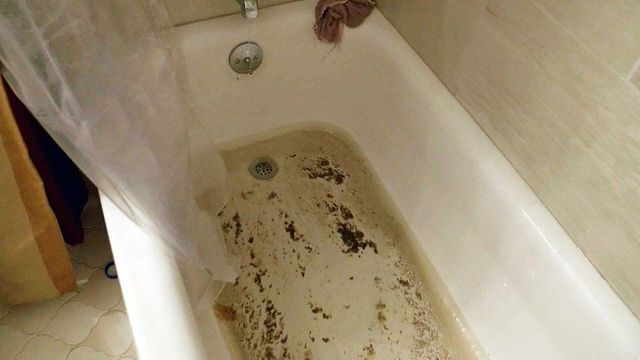Exploring the Phenomenon of Discharge Rising Through the Bathtub
Exploring the Phenomenon of Discharge Rising Through the Bathtub
Blog Article
We have noticed this great article about Why sewage is coming up through your bathtub below on the internet and concluded it made good sense to discuss it with you on this site.

Sewer back-up in the bathtub can be a traumatic and unsanitary trouble for any kind of house owner. Not just is it bothersome, yet it also presents severe health and wellness dangers and shows underlying concerns with the plumbing system. Understanding why sewage is turning up via the bathtub is critical for taking proper activity to resolve the trouble properly.
Intro to the Concern
Comprehending the Problem
When sewage starts backing up right into the tub, it's a clear indicator of a trouble with the drainage system. The wastewater that needs to be flowing away from your home is instead finding its way back right into your space, which can lead to considerable damages and carcinogen.
Prospective Reasons
Numerous aspects can contribute to sewage back-up in the tub. From clogs in the sewer line to concerns with the plumbing infrastructure, determining the origin is essential for finding a service.
Common Factors for Sewer Back-up
Obstructions in the Drain Line
One of the most usual sources of sewer backup is a clog in the sewer line. This can occur as a result of the build-up of particles, grease, or foreign items in the pipes, stopping proper flow and creating sewage to back up right into your bathtub.
Tree Root Breach
Tree roots looking for wetness and nutrients can penetrate drain lines with tiny fractures or joints. With time, these origins can expand and increase, causing significant damage to the pipelines and leading to sewer backup issues.
Aging Facilities
Older homes might have outdated plumbing systems that are much more at risk to deterioration, fractures, and wear and tear. As pipes age, they come to be more vulnerable to leakages and blockages, raising the likelihood of sewage back-up occurrences.
Heavy Rainfall or Flooding
Throughout durations of heavy rainfall or flooding, the drain system may end up being overloaded with excess water, causing backups and overflows. This can lead to sewage supporting right into bathtubs and various other fixtures inside the home.
Wellness Dangers Connected With Sewage Backup
Contamination of Water
Sewage backup can contaminate the water supply in your home, posing a major wellness danger to you and your family. Direct exposure to infected water can result in stomach problems, skin infections, and various other illnesses.
Spread of Condition
Sewer has hazardous bacteria, infections, and bloodsuckers that can create a variety of diseases, including liver disease, cholera, and gastroenteritis. Entering contact with sewer or polluted surface areas places you in jeopardy of infection.
Mold Growth
Moisture from sewer back-up can produce suitable problems for mold and mildew growth in your home. Mold and mildew spores can aggravate respiratory system troubles and trigger allergic reactions in delicate individuals, making timely cleanup necessary.
Indications of Sewer Back-up
Foul Odors
Undesirable smells rising from drains pipes or fixtures, especially in the restroom, may show sewer back-up issues. These odors are usually solid and persistent, signaling an issue that needs instant attention.
Slow Draining Fixtures
Bathtubs, sinks, and commodes that drain gradually or not whatsoever could be experiencing sewer backup. If numerous fixtures are impacted at the same time, it's most likely that the issue stems from a typical point, such as the major sewer line.
Gurgling Noises
Unusual gurgling or gurgling sounds originating from drains pipes when water is running elsewhere in your home are a sign of air entraped in the plumbing system. This air buildup can result from sewage back-up and ought to be checked out quickly.
Immediate Actions to Take
Shutting Off Water
In the event of sewer backup, it's necessary to switch off the water to avoid additional contamination and damage. Locate the major water shutoff valve in your home and shut it off until the issue can be solved.
Getting In Touch With a Specialist Plumber
Handling sewer back-up is not a DIY work. Call an accredited plumber with experience in handling sewage-related concerns to assess the situation and execute needed repairs or clean-ups.
Avoiding Contact with Infected Water
Up until the sewage backup is fixed, stay clear of contact with infected water to stop the spread of microorganisms and pathogens. Wear protective gear if you should remain in the affected location and wash your hands extensively later.
Safety nets
Regular Maintenance of Drain Lines
Schedule normal assessments and upkeep of your sewage system lines to identify and resolve prospective issues prior to they rise into significant troubles. This can include cleaning debris, checking for tree root invasion, and repairing any type of broken pipelines.
Mounting Bayou Shutoffs
Take into consideration mounting bayou valves in your plumbing system to prevent sewage from receding into your home throughout periods of heavy rainfall or flooding. These shutoffs immediately close when water draws back up, safeguarding your residential property from contamination.
Proper Disposal of Family Waste
Stay clear of purging anything apart from bathroom tissue and human waste down the commode to stop clogs and clogs in the sewage system line. Dispose of grease, oil, and other house chemicals correctly to decrease the danger of plumbing problems.
Tidying up After Sewage Backup
Disinfection Procedures
Extensively disinfect and sanitize influenced locations after sewage back-up to eliminate harmful bacteria and stop mold development. Usage suitable cleansing products and safety equipment to ensure safe and effective cleaning.
Repair of Influenced Locations
Fix any type of damages to floor covering, walls, or fixtures brought on by sewer backup. Relying on the level of the damage, you might need to change carpeting, drywall, or various other materials to restore your home to its pre-loss condition.
Sewage Coming Up Through the Bathtub?
Understanding the Plumbing System:
To understand why sewage is coming up through your bathtub, it is essential to have a basic understanding of the plumbing system. The plumbing system is a complex network of pipes, valves, fixtures, and drains that work together to provide clean water to your home and remove waste and sewage. The system consists of two parts: the supply system and the drainage system.
The supply system brings clean water to your home, while the drainage system removes wastewater from your sinks, toilets, showers, and bathtubs. The drainage system is connected to the main sewer line, which carries the wastewater to the municipal sewage treatment plant or septic tank.
Causes of Sewage Coming Up Through the Bathtub:
Sewage coming up through the bathtub can be caused by various factors. Some of the most common causes are:
Clogged Drain Pipes:
One of the most common reasons for sewage coming up through the bathtub is a clogged drain pipe. Over time, debris, hair, soap scum, and other foreign objects can accumulate in the drain pipes, leading to a blockage. This can cause the wastewater to back up and come out of the bathtub.
Main Sewer Line Blockage:
Another reason for sewage coming up through the bathtub is a blockage in the main sewer line. The main sewer line connects your home’s drainage system to the municipal sewer system. If the main sewer line gets clogged due to tree roots, grease buildup, or other obstructions, it can cause sewage to back up into your home’s plumbing fixtures, including the bathtub.
Sewage Backup:
Sewage backup is another common cause of sewage coming up through the bathtub. Sewage backup occurs when there is a problem with the municipal sewer system, such as heavy rainfall, flooding, or a malfunctioning pump. When this happens, sewage can flow back into your home’s drainage system and cause sewage backup in your plumbing fixtures, including the bathtub.
Broken or Damaged Pipes:
Finally, broken or damaged pipes can also cause sewage to come up through the bathtub. Over time, pipes can deteriorate due to age, corrosion, or external factors such as shifting soil. When pipes break or crack, wastewater can leak out and cause sewage backup in your plumbing fixtures.
Signs of Sewage Coming Up Through the Bathtub:
Some of the signs that sewage is coming up through your bathtub include:
Foul odor: If you notice a strong, unpleasant odor coming from your bathtub drain, it could be a sign of sewage backup. The smell is caused by the buildup of organic waste in the pipes. Slow drainage: If your bathtub drains slowly or not at all, it could be a sign of a clogged drain pipe or a more severe problem with the main sewer line. Gurgling sounds: If you hear gurgling sounds coming from your bathtub drain or other plumbing fixtures, it could indicate that air is trapped in the pipes due to a blockage. Prevention Measures:
The best way to prevent sewage from coming up through the bathtub is to take preventative measures. Here are some practical tips:
Regular Drain Cleaning:
Regular drain cleaning can help prevent clogs and keep your pipes in good condition. You can use a plunger, drain snake, or enzymatic drain cleaner to remove any buildup of hair, soap scum, or other debris in your bathtub drain.
Proper Waste Disposal:
Improper waste disposal can also contribute to sewage backup. Avoid flushing non-biodegradable items, such as paper towels, feminine hygiene products, or wipes down the toilet. Also, be mindful of what you pour down the drain, such as grease, oil, or coffee grounds, as they can cause clogs.
Professional Plumbing Maintenance:
Regular plumbing maintenance can help prevent plumbing emergencies, such as sewage backup. A professional plumber can inspect your pipes, identify any potential issues, and perform preventative measures, such as hydro jetting, to clean your pipes.
Hydro Jetting:
Hydro jetting is a powerful method that uses high-pressure water to clean the pipes thoroughly. It can remove even the most stubborn clogs and prevent future blockages.

We were brought to that article on Water Coming up Bathtub Drain through a friend on another domain. Sharing is nice. Helping others is fun. Thanks a bunch for your time. Come back soon.
Course Detail
Report this page